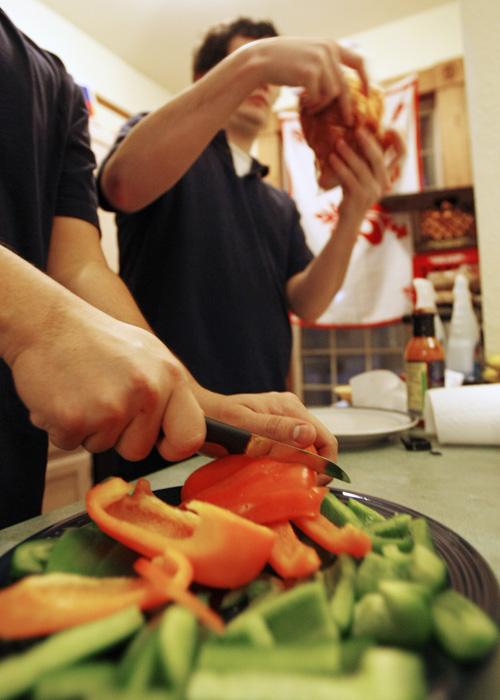Ways to cook healthy available for all
A student cooks an apartment meal Sunday. Eating healthy food inside your apartment after leaving the residence halls can be difficult, especially during late-night study sessions. One solution for students looking for a healthier diet is preparing health Erica Magda
Feb 5, 2008
A typical college apartment refrigerator contains milk, soda, moldy vegetables and last night’s pizza or Chinese food.
With so many things to stress about, exams and papers can come before a balanced diet.
It is essential for active students to consume foods with vitamins and minerals to fuel the body and brain.
Carol Schlitt, a University of Illinois Extension educator for nutrition and wellness, offers some tips for grocery shopping.
“When you go to the grocery store, stock up on healthy snack foods such as baby carrots, hummus, low-fat yogurt and low-fat dairy products,” Schlitt said.
Get The Daily Illini in your inbox!
Foodfit.com, a Web site that compiles information from public health organizations, dieticians, fitness experts and chefs, gives college students more tips on healthful shopping.
The Web site recommends building meals around vegetables, chicken or fish, and beans.
Choosing high-fiber foods such as whole-grain cereal and breads and choosing fresh fruit as a snack or part of the meal helps keep the immune system strong, according to the site.
Between buying books and paying rent, most college students do not have a large amount of money to spend on groceries.
But healthy does not have to mean expensive.
The Wellness Ways Newsletter posted by the College of ACES notes that canned fruits and vegetables are good for a budget and healthy eating.
It is best to buy vegetables with no salt added and fruits packed in 100 percent fruit juice or light syrup for full health benefits, according to the newsletter.
Rebecca Roach, teaching associate of food science and human nutrition, said that some frozen foods are healthy and more cost effective. Just as with the canned foods, make sure there is no added sugar or salt.
Fresh fruits in season such as apples, day-old whole grain bread from the bread stores, rice and large containers of low-fat yogurt are a few of the cost-efficient foods Schlitt recommended.
The key to a healthy diet is moderation and variety, Roach said.
“I’m one of those people who believes there is no bad food. There’s room for every food in a healthy diet,” she said.
Living away from home and without the buffet-style meals in the dining halls for the first time requires cooking for yourself. Schlitt gave some examples of simple and healthy meals that college students can prepare.
Making your own pizza is a good alternative to eating greasy delivery pizza. Schlitt said to use lean meats, plenty of veggies and low-fat cheese as toppings.
A quick stir fry is easy to make. Just fry frozen mixed vegetables with teriyaki sauce and add chicken or shrimp. Serve over rice.
Schlitt also recommended investing in a crock pot.
During the next late-night study session, think twice before ordering a pizza, and try something healthy instead.






